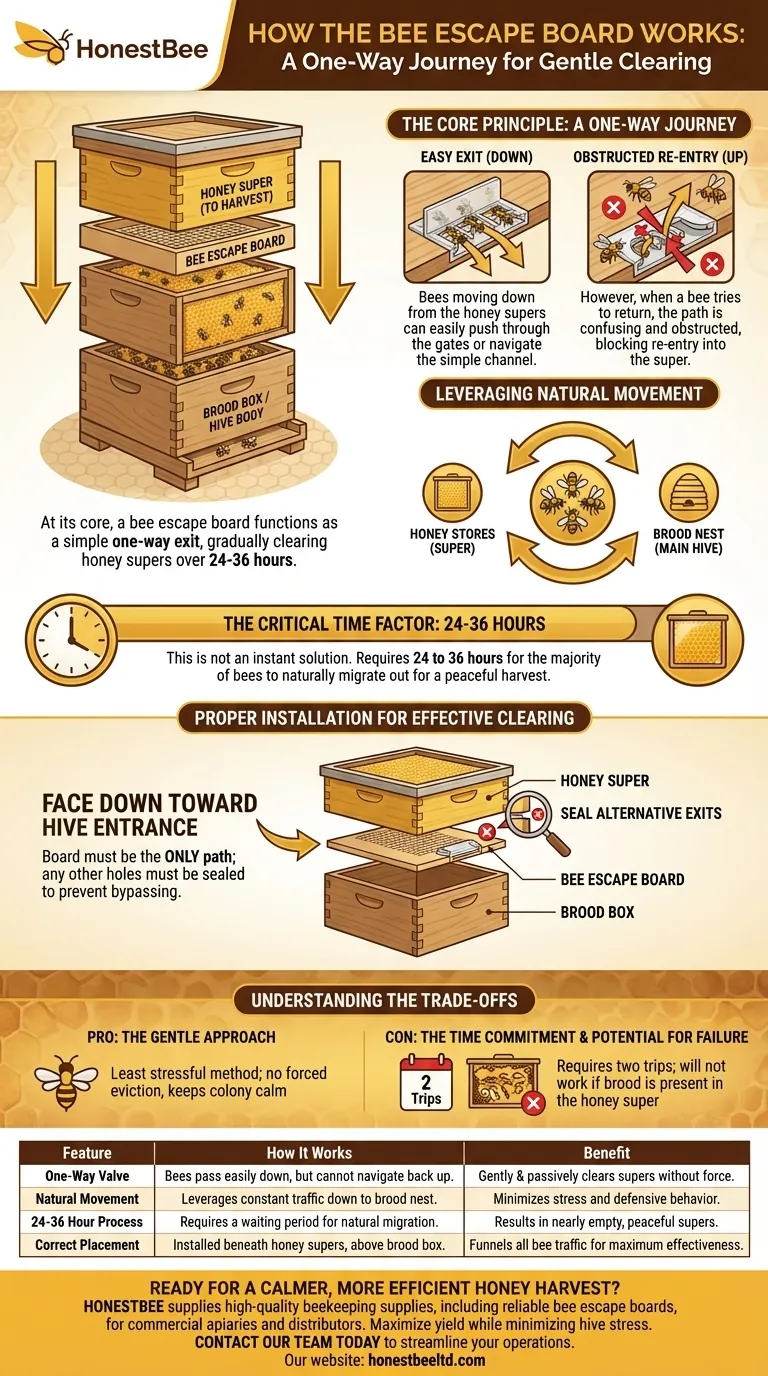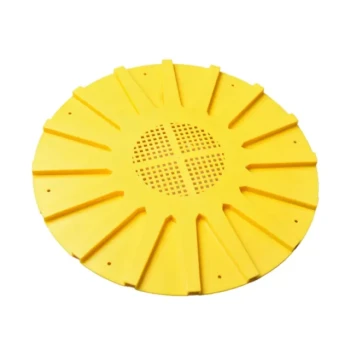At its core, a bee escape board functions as a simple one-way exit. It is a specialized board placed between the honey supers you intend to harvest and the main hive body below. The board contains one or more gates that are easy for bees to pass through in one direction (down) but difficult, if not impossible, to navigate in the reverse direction (up).
The bee escape board is a passive tool that leverages the bees' natural movement within the hive. By creating a one-way path, it gradually and gently clears the honey supers over 24-36 hours, making harvest day significantly calmer for both the bees and the beekeeper.

The Core Principle: A One-Way Journey
A bee escape board works by creating a simple navigational puzzle that bees can only solve in one direction. It capitalizes on the colony's constant internal traffic without causing alarm or stress.
The "Valve" Mechanism
The "escapes" themselves are small plastic or metal inserts in the board. These are designed as one-way valves. Bees moving down from the honey supers can easily push through the gates or navigate the simple channel.
However, when a bee tries to return, the path is confusing and obstructed, effectively blocking re-entry into the super.
Leveraging Natural Bee Movement
Bees are constantly moving between the brood nest and the honey stores. The board simply funnels this natural downward traffic. As bees complete their work in the honey super or move down to cluster for the night, they pass through the escape and cannot return.
The Critical Time Factor
This is not an instant solution. The process relies on the gradual movement of the colony over time. You must install the board and wait 24 to 36 hours for it to be effective. This period allows the vast majority of bees to naturally migrate out of the supers, leaving them nearly empty and ready for a peaceful harvest.
Proper Installation for Effective Clearing
For the board to work, it must be the only path for the bees to travel between the honey super and the rest of the hive.
Correct Placement
The bee escape board is always placed directly beneath the honey super(s) you plan to harvest and above the lower hive bodies or brood boxes.
Correct Orientation
Most escape boards have a specific "up" and "down" side. A common design features a screened triangle or opening on the bottom. This side must face downward, toward the main hive entrance, to allow the bees to exit properly.
Sealing Alternative Exits
The honey super being cleared must be bee-tight. If there are any other cracks, holes, or upper entrances, the bees will simply bypass the escape board, rendering it useless. For hives like a Warre, this may require modifying a separator canvas to ensure bees are funneled through the escape.
Understanding the Trade-offs
While effective, the bee escape board is a specific tool for a specific approach and is not without its limitations.
Pro: The Gentle Approach
This is arguably the least stressful method for clearing bees. Unlike brushing, blowing, or using fume boards, it doesn't forcibly evict them, which keeps the colony calm and reduces defensive behavior.
Con: The Time Commitment
The biggest drawback is the need for two separate trips to your apiary. You must visit once to install the board and then return 1-2 days later to collect the cleared supers. This makes it impractical for beekeepers who need to complete the harvest in a single visit.
Potential for Failure
The board will not work if there is any brood (unhatched bees) in the honey supers. Nurse bees will not abandon the brood, and the super will remain full of bees. Always ensure the queen has been kept out of your honey supers with a queen excluder.
Is the Bee Escape Board Right for Your Harvest?
Choosing your clearing method depends entirely on your goals, beekeeping philosophy, and time constraints.
- If your primary focus is a calm, low-stress harvest: The bee escape board is an excellent choice that minimizes disruption to the colony.
- If your primary focus is speed and efficiency: A different method like a bee brush or leaf blower might be better, as this tool requires a 24-36 hour waiting period.
- If you are a new beekeeper: This tool is highly recommended because it simplifies the harvest and reduces the chance of agitating the colony during a critical learning process.
By understanding its simple one-way design, you can make honey harvesting a significantly calmer and more pleasant experience for you and your bees.
Summary Table:
| Feature | How It Works | Benefit |
|---|---|---|
| One-Way Valve | Bees pass easily down but cannot navigate back up. | Gently and passively clears supers without force. |
| Natural Movement | Leverages bees' constant traffic down to the brood nest. | Minimizes stress and defensive behavior in the colony. |
| 24-36 Hour Process | Requires a waiting period for bees to migrate out naturally. | Results in nearly empty, peaceful supers for easy harvest. |
| Correct Placement | Installed beneath honey supers, above the brood box. | Funnels all bee traffic through the escape for maximum effectiveness. |
Ready for a calmer, more efficient honey harvest?
As a commercial beekeeper or distributor, your time and the well-being of your colonies are paramount. The right equipment makes all the difference.
HONESTBEE supplies high-quality beekeeping supplies and equipment—including reliable bee escape boards—through our wholesale-focused operations. We help commercial apiaries and distributors maximize yield while minimizing hive stress.
Contact our team today to discuss your equipment needs and discover how our products can streamline your beekeeping operations.
Visual Guide

Related Products
- HONESTBEE Multi Exit Plastic Bee Escape Board for Efficient Honey Harvesting
- Circular Labyrinth Bee Escape for Efficient Hive Management
- Efficient Hive Clearing: HONESTBEE 8-Way Plastic Bee Escape
- Professional Durable Two-Piece Plastic Bee Escape
- HONESTBEE Wooden Bee Escape Board with Triangle Mesh Design for Beekeeping
People Also Ask
- How should bee escape boards be used for optimal results? A Guide to a Calm, Efficient Honey Harvest
- How long should you wait after placing a bee escape board before harvesting honey? Clear Your Supers in 24-48 Hours
- How is the Triangle Bee Escape Board placed when removing a super? Master the Correct Placement for a Stress-Free Harvest
- What is the method of separating bees from honey supers using the Bee Escape Board? A Gentle, Low-Stress Harvesting Guide
- What happens to the bees when a bee escape board is used? A Gentle, Chemical-Free Harvest Method



















